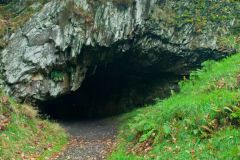
Gold has been mined at this wooded spot near the village of Pumsaint since the Bronze Age, if not earlier. The Romans were well aware of the Dolcauthi mines before their invasion of Britain in the first century AD; in fact, it seems likely that the presence of gold at Dolaucothi was one of the factors that influenced the Romans to invade Britain in the first place.
The Roman Mines
The Romans took over the mine here in about AD 75 and established a fort at the site now occupied by the village of Pumsaint. The Roman mines were worked until about AD 150, and some of the rectangular Roman tunnels can still be seen. After the Romans left, the mines were left for over 1600 years, until the Victorians reopened workings. A succession of companies worked Dolaucothi throughout the 19th century and early 20th century until the mines finally closed in 1939.

Visiting Dolaucothi
Visitors to Dolaucothi today can see exhibits covering the history of mining at the site. There are displays on gold mining throughout history and Victorian mining equipment. Visitors can also try their hand at panning for gold, and take home their finds, and there is a children's area with activities and educational materials. You can take in a 'Roman walk' which offers views over the 1930s mining yard.
Mine Tours
There are two optional tours available. These are free of charge and offered throughout the day, but must be booked on arrival, and places are limited. The first, shorter tour, provides a taste of what the mines are all about, with a glimpse into a level Roman mine adit.
The longer tour takes visitors kitted out with miner's helmets and lanterns right into the mines, through narrow tunnels, and shows what life was like for miners. The going on this tour can be damp, and good footwear is strongly advised, as is a healthy sense of adventure!
The reward for your endeavours in a vivid experience of an authentic Victorian gold mine, with glimpses into the earlier Roman mine. Dolaucothi is a designated SSSI (Site of Special Scientific Interest) on two counts. The first reason for this designation is the presence of unique lichens and mosses. The second is the presence of the rare mineral Cookite (Lithium Hydroxide Silicate).
Dolaucothi for Families
Families will enjoy a visit to Dolacothi; there is plenty for children to see and do, and kids will enjoy the underground tour of the mines - ours did! The Dolaucothi estate, which stretches to over 2000 acres, also has miles of walking trails through spectacular scenery.
About Dolaucothi Gold Mines
Address: Pumsaint,
Llanwrda,
Carmarthenshire,
Wales, SA19 8US
Attraction Type: Roman Site
Location: on A482
Website: Dolaucothi Gold Mines
Email: dolaucothi@nationaltrust.org.uk
National Trust - see also:
National Trust memberships (official website link)
Location
map
OS: SN662 399
Photo Credit: David Ross and Britain Express
HERITAGE
 We've 'tagged' this attraction information to help you find related historic attractions and learn more about major time periods mentioned.
We've 'tagged' this attraction information to help you find related historic attractions and learn more about major time periods mentioned.
Historic Time Periods:
Find other attractions tagged with:
19th century (Time Period) - 4th century (Time Period) - Bronze Age (Architecture) - Roman (Time Period) - Victorian (Time Period) -
NEARBY HISTORIC ATTRACTIONS
Heritage Rated from 1- 5 (low to exceptional) on historic interest
Pumsaint Roman Fort (Luentinum) - 0.6 miles (Roman Site) ![]()
Talley Abbey - 4.8 miles (Abbey) ![]()
Lampeter Castle - 7.3 miles (Castle) ![]()
Llanfair-ar-y-bryn, St Mary's Church - 7.3 miles (Historic Church) ![]()
Llandovery Castle - 7.4 miles (Castle) ![]()
Llandovery Roman Fort (Alabum) - 7.4 miles (Roman Site) ![]()
Llangadog Castle (Castell Meurig) - 8.2 miles (Castle) ![]()
Garn Goch Hill Fort - 9.9 miles (Prehistoric Site) ![]()










